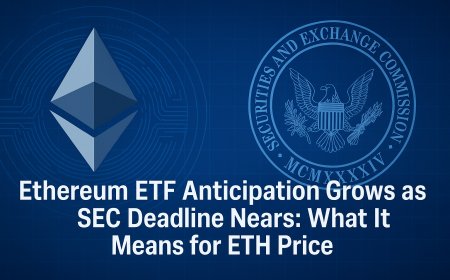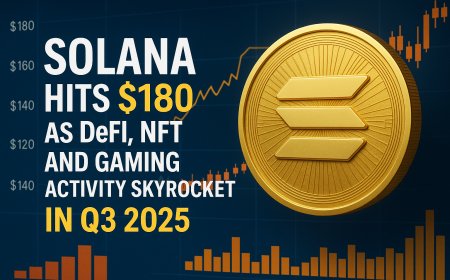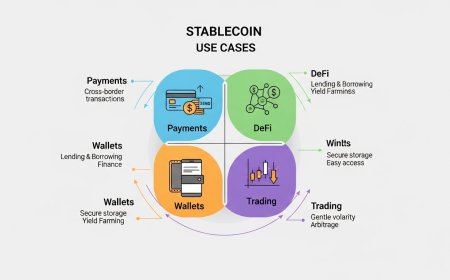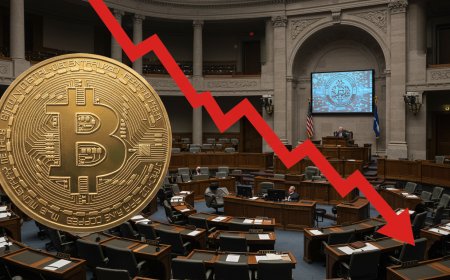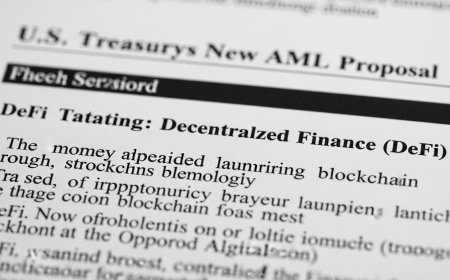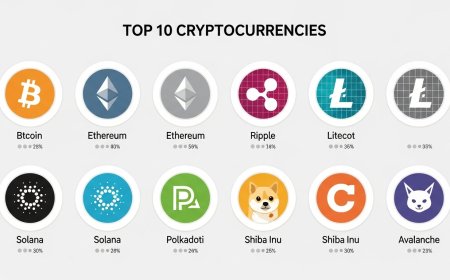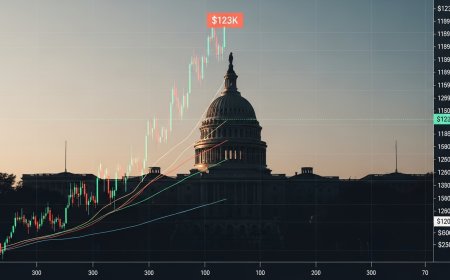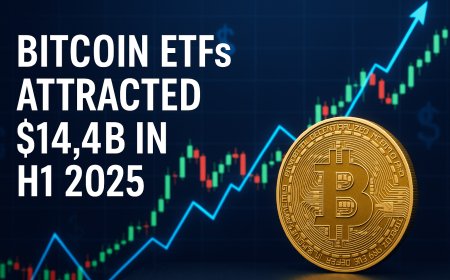The $120 Billion Bitcoin ETF Explosion: Why Wall Street Can't Stop Buying
Bitcoin ETFs hit $120 billion in inflows with $1.18B single-day records. BlackRock leads institutional stampede as Wall Street rewrites Bitcoin adoption playbook. Complete analysis inside.

The $120 Billion Bitcoin ETF Explosion: Why Wall Street Can't Stop Buying
Record inflows reveal institutional FOMO as Bitcoin ETFs rewrite financial history
Something unprecedented is happening in traditional finance, and most retail investors are completely missing it. While crypto Twitter argues about the next memecoin, Wall Street has gone absolutely nuclear on Bitcoin ETFs, with inflows surpassing a staggering $120 billion in 2025.
This isn't just another bullish statistic—it's the complete transformation of how institutional money views Bitcoin. And if you understand what's driving these record inflows, you'll see why we're still in the early innings of the biggest wealth transfer in financial history.
The Numbers That Change Everything
Let's start with the jaw-dropping data that's rewriting the Bitcoin playbook:
- $1.18 billion in single-day ETF inflows (the biggest day of 2025)
- $50 billion in cumulative net inflows reached as a defining milestone
- $6.3 billion daily trading volume across all 12 Bitcoin ETFs
- BlackRock's IBIT alone: $763.9 million in recent inflows
The $50 billion mark in cumulative net inflows is a defining moment for bitcoin's institutionalization, and we're just getting started.
What's Really Driving This Institutional Stampede
The Treasury Revolution
Growing demand from institutional investors for moving bitcoin into treasury portfolios and ETFs represents a fundamental shift in corporate finance strategy. Companies aren't just buying Bitcoin for speculation—they're treating it as a treasury asset alongside cash and bonds.
The Corporate Playbook:
- Risk Management: Bitcoin provides hedge against currency debasuation
- Yield Enhancement: Superior returns compared to traditional treasury assets
- Future-Proofing: Positioning for digital asset integration
BlackRock's Dominance Strategy
BlackRock's spot Bitcoin ETF closed out the week with a $356.2 million inflow, marking a straight week of inflows and extending its streak to 19 consecutive days — the longest run of 2025 so far.
BlackRock isn't just participating in the Bitcoin market—they're systematically dominating it. Their IBIT ETF has become the preferred vehicle for institutional Bitcoin exposure, and the momentum is accelerating.
Why BlackRock Wins:
- Lowest fees in the industry
- Superior liquidity management
- Institutional-grade security and custody
- Brand trust that pension funds and institutions require
The Regulatory Catalyst Effect
The timing isn't coincidental. The influx of $68 billion into Bitcoin ETFs in 2025 marks a pivotal moment in cryptocurrency history, reflecting a decisive shift toward institutional adoption and regulatory maturity.
The GENIUS Act's passage created the regulatory clarity that institutional investors demanded. Now they're flooding in with capital that was previously sitting on the sidelines.
The Market Structure Revolution
Liquidity Transformation
This influx of capital has not only elevated Bitcoin's market capitalization beyond $2 trillion but also enhanced liquidity and market stability, attracting further interest from traditional finance sectors.
Bitcoin is no longer a volatile speculative asset in institutional eyes—it's becoming mature financial infrastructure with predictable liquidity and institutional-grade market depth.
The Volatility Paradox
Here's the counterintuitive reality: Massive institutional inflows are actually reducing Bitcoin volatility, which attracts even more institutional money. It's a self-reinforcing cycle that's fundamentally changing Bitcoin's market dynamics.
The New Reality:
- Lower volatility attracts conservative institutional mandates
- Improved liquidity reduces trading costs and slippage
- Regulatory clarity eliminates compliance uncertainty
- Professional custody solutions meet fiduciary standards
The $68 Billion Forecast: Why This Is Just the Beginning
Institutional Investors May Drive $68 Billion Inflows into Bitcoin ETFs Amid Regulatory Advances—and that's just one projection. The reality could be much larger.
The Pension Fund Wave
Most pension funds haven't even started their Bitcoin allocations yet. A typical 1-2% allocation from major pension systems could dwarf current ETF inflows.
The Math:
- US pension assets: ~$35 trillion
- 1% allocation = $350 billion potential inflow
- Current ETF market: $120 billion
- Potential growth: 3x current size from pensions alone
The Sovereign Wealth Opportunity
Trump's Strategic Bitcoin Reserve executive order signals that even governments are treating Bitcoin as a strategic asset. This legitimizes Bitcoin for sovereign wealth funds globally.
International FOMO
The approval and expansion of Bitcoin ETFs have been instrumental in bridging the gap between traditional finance sectors, and international markets are racing to launch competing products.
Global ETF Launch Pipeline:
- European Bitcoin ETFs expanding
- Asian markets developing similar products
- Emerging markets considering Bitcoin reserves
- Central banks exploring Bitcoin holdings
The Trading Volume Explosion
Total trading volume across the 12 bitcoin ETFs hit $6.3 billion, the highest daily level since late May. This isn't retail speculation—this is institutional rebalancing and strategic allocation.
What High Volume Means:
- Price Discovery: More efficient Bitcoin pricing
- Reduced Spreads: Lower costs for all participants
- Market Maturity: Bitcoin behaving like traditional assets
- Institutional Comfort: Professional traders prefer liquid markets
Investment Strategy Implications
The New Asset Allocation Model
Traditional 60/40 stock/bond portfolios are being replaced by 50/35/15 models that include Bitcoin allocation. This structural shift creates perpetual bid pressure on Bitcoin.
The Early Advantage Window
Bitcoin ETFs have experienced a significant rebound, recording $408 million in net inflows on July 2, 2025, but we're still in the early stages of institutional adoption.
Timeline Advantage:
- Phase 1 (Current): Early institutional adopters
- Phase 2 (Next 12 months): Pension fund allocations begin
- Phase 3 (12-24 months): Sovereign wealth fund adoption
- Phase 4 (2+ years): Central bank Bitcoin reserves
Portfolio Positioning Strategy
Immediate Actions:
- Direct Bitcoin Exposure: Consider 5-10% portfolio allocation
- ETF Diversification: Spread across multiple providers (IBIT, FBTC, BITB)
- Mining Stocks: Leverage play on Bitcoin price appreciation
- Crypto Infrastructure: Companies facilitating institutional adoption
Risk Management:
- Dollar-cost average over 3-6 months
- Rebalance quarterly to maintain target allocation
- Use stop-losses below major technical support levels
- Monitor institutional flow data for trend changes
The Paradigm Shift Nobody Saw Coming
This influx is not merely a statistic; it symbolizes a seismic shift in the perception of Bitcoin among institutional players, who are increasingly embracing it as a credible investment.
We're witnessing the transformation of Bitcoin from digital gold to digital infrastructure. The institutions buying today aren't planning to sell—they're building strategic positions for the next decade.
What This Means for Bitcoin's Price
With $120 billion in ETF inflows and accelerating institutional adoption, Bitcoin's supply-demand dynamics have fundamentally shifted. When pension funds and sovereign wealth funds start allocating, current prices will look like historical footnotes.
The Supply Reality:
- Only 21 million Bitcoin will ever exist
- ~19.5 million already mined
- Large portions held by long-term investors
- ETFs creating permanent bid pressure
- Institutional buyers competing for limited supply
Bottom Line: The Institutional Revolution Is Here
The $120 billion in Bitcoin ETF inflows represents more than investment success—it's proof that Bitcoin has achieved institutional legitimacy. The world's largest asset managers, pension funds, and treasury departments are no longer asking "if" they should own Bitcoin, but "how much."
This isn't a speculative bubble—it's the systematic integration of Bitcoin into the global financial system. The institutions buying today are positioning for a future where Bitcoin is as common in portfolios as stocks and bonds.
The opportunity window is narrowing fast. By the time retail investors realize what's happening, institutional prices will be out of reach.
The smart money isn't waiting for permission—they're already here.
What's Your Reaction?
 Like
0
Like
0
 Dislike
0
Dislike
0
 Love
0
Love
0
 Funny
0
Funny
0
 Angry
0
Angry
0
 Sad
0
Sad
0
 Wow
0
Wow
0









